Are Bigger Pearls Better? What's the Right Pearl Size for You?

"The rarest things in the world, next to a spirit of discernment, are diamonds and Pearls." – Jean de la Bruyere.
In case you missed it, the return and modernization of old fashion trends are the themes of 2023, so it's not surprising that pearls are making a solid comeback.
So, that begs the question: does size matter when shopping for the perfect pearl?
The answer is yes!
However, different from the manner you think. Pearls of various sizes can impact the overall appearance of a dress, match numerous styles, and suit people differently. In short, there's no straightforward answer.
Although there isn't a universal standard, I'll explain how to choose the best pearl size for you.
What is the standard pearl size?
Pearl size is essential in determining a pearl's quality and worth. A pearl's size, measured in millimeters, may range between 2 and 20mm depending on its nature and the time it took to culture. So, how do the sizes of various varieties of pearls differ? What factors should you consider while selecting the appropriate size for your jewelry?
Today's most popular and typical sizes vary from 6.0-6.5mm to 9.0-9.5mm pearls.
Pearls lower than 7mm are considered small, whereas 7-8mm and 8-9mm are standard for Freshwater pearl necklaces. Anything measuring 9-10mm and above is regarded as above average in size, and such pearls are more scarce and pricey.
The most popular pearl sizes to buy
Akoya pearl
Akoya pearls are cultured from proportionally small oysters influencing the pearl's final size. It might surprise you that the Akoya Oyster is the smallest mass-produced pearl oyster. The average Akoya pearl oyster is around seven millimeters in size; however, they may vary between one and ten millimeters after the culturing process.
Tahitian

High-quality genuine Tahitian pearls are enormous, ranging in size from about 8 mm to 18mm. Currently, the only bigger commonly produced pearls are South Sea pearls. The size of a Tahitian pearl is heavily dependent on its diameter. The average Tahitian pearl is around 13 mm in diameter.
South Sea pearl

Owing to the uniquely large Pinctada maxima oysters, the south sea pearls are the largest commercially produced pearls. South Sea pearls vary from 8 to 20 mm, with an average of 12 mm. Despite being highly unusual, several pearls bigger than 20 mm have been discovered.
Freshwater pearls

Freshwater pearls are the next smallest pearl size after the Akoya. Freshwater pearl sizes vary from little 2.0 mm seed pearls to 11.0 - 12.0 mm. Pearl diameters consistently reach 15.0 - 16.0 mm and are even larger for some new Freshwater pearl brands, such as Edison or Souffle.
The most common sizes of freshwater pearls for necklaces, bracelets, and earrings are typically 6.0-7.0 mm, 7.0-8.0 mm, and 8.0-9.0 mm.
Popular pearl necklace sizes
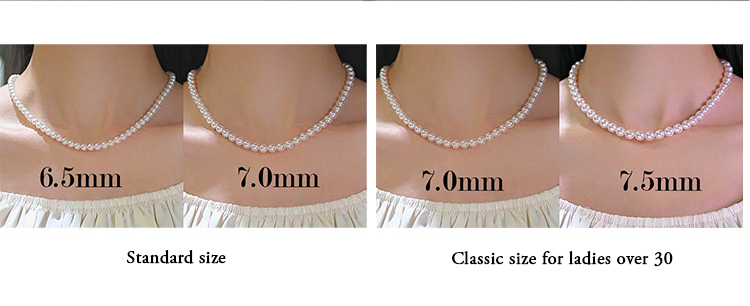
● 6.5 - 7.0 mm: This is the standard size for most pearls sold on the market. Price Range: $370 - $1,100
● 7.0 – 7.5 mm: The classic choice for ladies over 30, and great for making a polished and elegant statement without being overly loud. $720 - $4,000
Popular pearl earring size
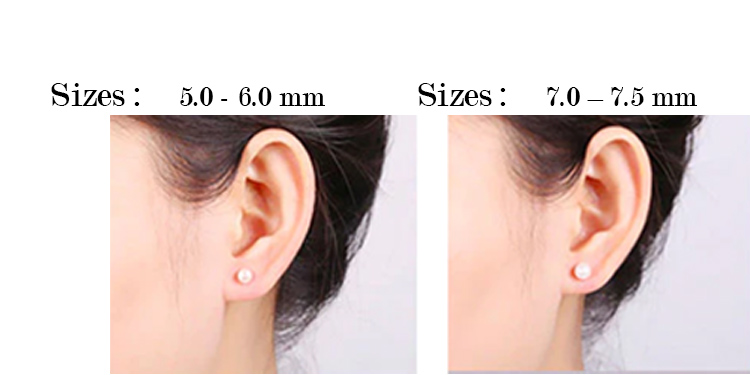
● 5mm to 6mm: These little pearl sizes are suitable for teenagers or those who want a more subdued aesthetic. They're ideal for daily use and look great with almost any outfit.
● 7.0-7.5mm: This is the most common pearl earring and classic pearl stud size.
Other matters to note in selecting pearls
Age
When selecting a pearl to buy, naturally, you will discover that some sizes are
appropriate for specific age groups. However, the tips below are just mere suggestions. You can rock any size pearl at any age and look dazzling in them.
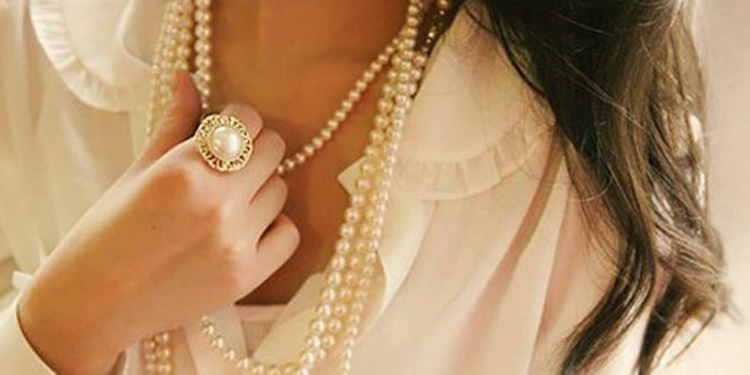
- 12-16 years old or younger
5-6mm is the standard pearl size adorned by teenagers. This is because pearls of this size are portable and delicate. They are also compatible with petite women who like smaller-sized jewelry. It complements their look by projecting a delicate, sweet, and innocent aura.
Pearls of this size are perfect for celebrating a young woman's coming-of-age at a bat mitzvah, confirmation, sweet sixteen, or quinceanera. They are also thoughtful presents for a teen's birthday, Christmas, academic accomplishment, or another special occasion.
- 16 to 25 years old

6-7mm - This is the conventional size for young females aged 16 to 25 and will typically be freshwater pearls and Akoya. These pearls are still modestly sized for a younger woman. Nonetheless, they are big enough for a taller teenager.
- 25-30 years old
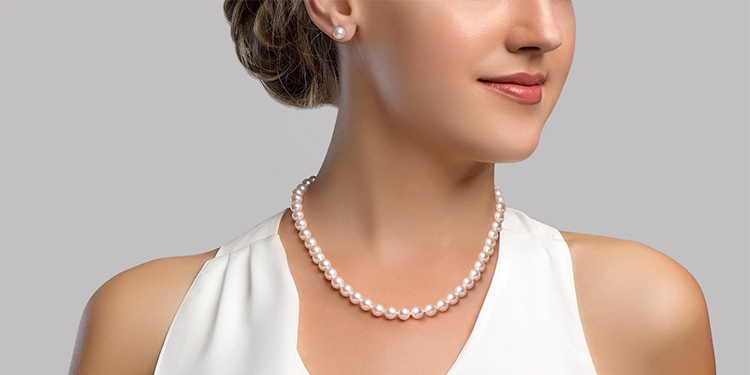
Pearls measuring 7-8 mm are often worn by ladies over 30. Size-wise, this pearl necklace is perfect for a young lady. They provide an air of professionalism to any outfit. So, they are perfect for corporate attires, such as employment interviews. They give any working lady an aura of confidence and authority. There is no way to go wrong with this necklace, also known as the "Classic Pearl Necklace."
- 30-37 years old
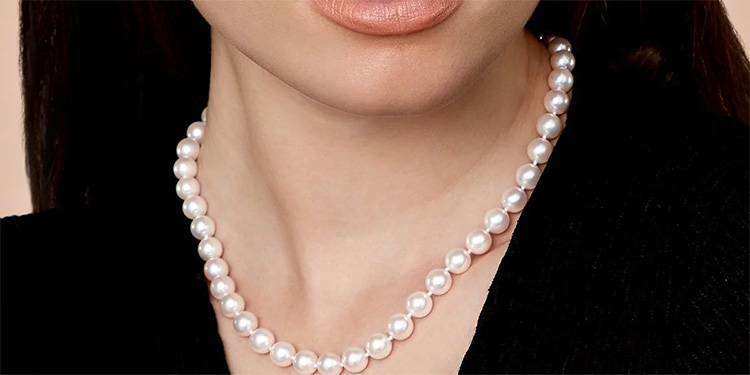
The premium pearl line begins in the 8–9 mm size range. These pearls will have a lovely "gravitas" and seem somewhat bigger than typical, making for an attractive and glamorous appearance. Most of the time, they will be pearls from the South Sea, Tahiti, or Akoya; however, high-quality Fresh Water pearls can also be used.
- 38-45 years old

Women between the ages of 38 and 45, especially those in their thirties who have achieved extraordinary success, often choose 9 to 11 mm Freshwater, Tahitian, or South Sea pearls. This is an excellent supplement to any outfit. Pearl jewelry set with beautiful stones is a great choice for professional ladies who wish to spice up their looks.
- 45 years and above
Above 11 mm -For women over 45, larger pearl strands of 11mm and higher are ideal. These strands look best in Tahitian and South Sea Pearl kinds, although Akoyas (which are challenging to locate in these sizes) and FreshWater Pearls would also work. When it comes to quality, these jewels may be rather pricey.
Body Shape
Generally, petite ladies are advised to select smaller pearls, whereas plus-size people choose bigger pearls. However, if these recommendations do not suit you, disregard them. When it comes to pearls, there is no universal rule; the vital guideline is to wear the size of pearl you want and feel comfortable with!
Style

As already mentioned, the most famous pearl size used in producing pearl jewelry is about 7-8mm. This is due to the versatility of single-strand pearl jewelry, made up primarily of 7-8mm pearls. They have a classic look that never goes out of style and a commanding presence that doesn't overwhelm them.
If you have a sophisticated style, you would prefer pearl sizes of about 9-10mm or more – which capture the essence of the pearl's luster. In contrast, 6-7mm pearls are more subtle and may be worn with everything from formal attire to jeans and a t-shirt.
Budget
Your budget is essential to select your pearl size, If not the most important.
That said, a bigger pearl size may complement your size but may be far over yours. Altogether, the size of a pearl is directly proportional to the cost. Put another way, the bigger the size, the more expensive it gets. This is predominantly due to the extended time bigger pearls take to culture.
Colour

When selecting your pearl jewelry, the color is also a factor to consider alongside the pearl size. One of the many intriguing things about these stones is how they get their color, and color may also affect the price. Consequently, not all pearls of a given color grow to be extremely large, so your choice of color may also limit your size options.
White pearls are the most prevalent color. These sparkling stones are the most popular hue for weddings, anniversaries, and college graduations because they represent their purity. The second most sought-after hue is black, which is most often associated with Tahitian pearls. The Tahitian pearl oyster, Pinctada maxima, is responsible for producing this pearl. Then we also have the golden pearls, which are grown in South sea pearl oysters and average sizes between 8-20mm.
Final thoughts
We hope you've gained some insight into pearl sizes and can now choose the perfect one for your use. It all comes down to what you like and what you can afford. The bigger the pearl is, the more expensive, which makes it a good investment. However, only some people want a large gemstone, and many prefer a smaller stone's understated elegance.
So, whatever size pearl you choose, remember what famed journalist Ki Hackney stated "You can't ever go wrong with pearls. Perhaps pearls are a girl's best friend after all."




Leave a Comment